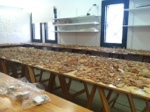For me, Monday was full of thinking about art and its many incarnations on Crete and beyond. We spent the afternoon following the journey of a pot at the Institute for Aegean Prehistory, an administrative center out of which excavations are run. Besides helping archeologists with the administrative parts of setting up an excavation, the center is also a place to process finds. First, an incoming piece of pottery from a place like Mochlos is washed and laid out in pieces on a large table.
 Then, as sherds of the pot are identified (like puzzle pieces), they move on to a new artist – the conservator. She carefully reconstructs the pot with tape, glue and patch ceramic, using a range of technologies like X-rays along the way. Next, a pot might head to the artist’s studio. There, another creative person handles the ancient work, this time to accurately reproduce the pot in a book drawing. Ink drawings used to prevail, but now the art is all done on a tablet. Now the pottery, despite the many artists who have worked on it, likely does not go to a museum. Instead, it is labeled and stored in a giant basement among the other finds.
Then, as sherds of the pot are identified (like puzzle pieces), they move on to a new artist – the conservator. She carefully reconstructs the pot with tape, glue and patch ceramic, using a range of technologies like X-rays along the way. Next, a pot might head to the artist’s studio. There, another creative person handles the ancient work, this time to accurately reproduce the pot in a book drawing. Ink drawings used to prevail, but now the art is all done on a tablet. Now the pottery, despite the many artists who have worked on it, likely does not go to a museum. Instead, it is labeled and stored in a giant basement among the other finds.
This trajectory is certainly not what a modern viewer has come to expect for a piece of artwork, including a Minoan pot. As many of us remarked at dinner, this art is approached differently, both in the Minoan world and in the world of archeology. Despite their communal goal, to recreate the work of the ancients, the staff at INSTAP are certainly individual artists. Likewise, I think we have all noticed the artistry of repeating Minoan designs (for example, sea creatures), even though ancient artists were privileging just a few pop images over the individuality we often value today. It’s a fascinating subject that was wonderful to discuss with my classmates, whose broad range of majors (History, Art History, Classics) brings to light ideas I never would have imagined as we enjoy the Cretan food that I’ve grown so attached to.


